This was published 6 years ago
Charles Rennie Mackintosh: On the trail of Glasgow's Gaudi
By Steve McKenna
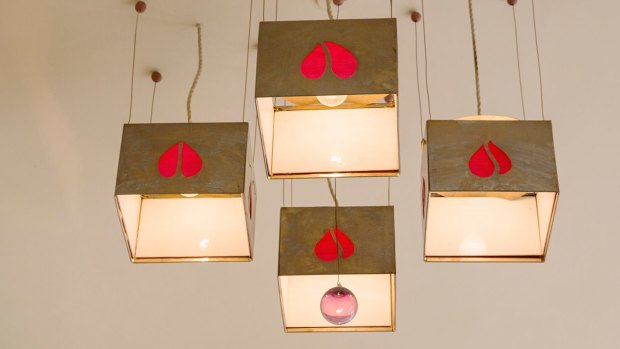
Lightshades in the Dining Room.
Even cloaked in scaffolding, the buttery sandstone building – the masterpiece of its revered, long-buried designer – remains a pilgrimage site for art and architecture buffs, and a magnet for other curious tourists keen to tick-off this ''must-see'' city icon. But we're not talking about La Sagrada Familia, Antoni Gaudi or Barcelona here.
This is the Glasgow School of Art, the comparatively unshowy jewel in the crown of Charles Rennie Mackintosh – a visionary Glaswegian whose decorative art nouveau designs sparked ripples across Europe's art scene in the early 20th century, and who, judging by the international crowd (Chinese, Japanese, American) purchasing coffee-table Mackintosh books in the school's sleek gift store and visitor centre, continues to inspire creative souls everywhere.
The landmark Mackintosh Building is still closed after a devastating fire in 2014, but you can always soak up the legacy of ''Glasgow's Gaudi'' in Scotland's largest city, especially during October's annual Creative Mackintosh Festival, when a raft of exhibitions, workshops and talks are staged in his memory. Most of the year, however, your best bet is to join a Mackintosh-themed walking tour run by the School of Art, the institution where he took art and design evening classes and met future wife, and life-time collaborator, Margaret Macdonald, before winning a competition to craft the school's new (now charred) building.
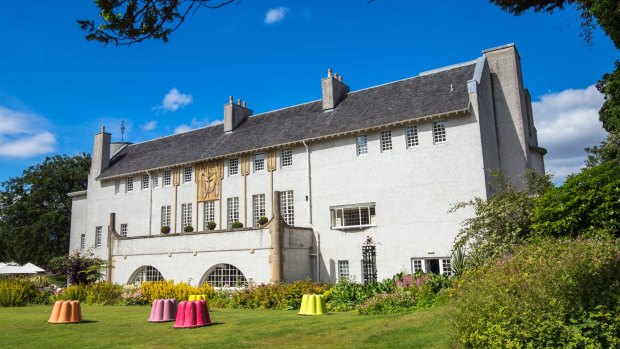
Scotland House for an Art Lover in Bellahouston Park.Credit: Visit Scotland
It was renowned for its intricate woody interior features, and the restoration is so meticulous – faithfully sticking to Mackintosh's original plans and materials – it won't be completed in time for next year's 150th anniversary events marking his birth. Glimmers of the building's beauty are still visible, though, with our guide, School of Art student Raheela Khan, pointing out the wrought-iron stems and buds, insects and birds on the scaffolded facade. Such curving, flowing flourishes were typical, she says, of Mackintosh, a moustached maverick, whose affection for art nouveau matched his indifference to the architecture he'd grown up with.
"Glasgow expanded ten-fold during the reign of Queen Victoria, booming thanks to its shipbuilding and textiles industries, and the city's wealthy industrialists wanted to adorn this workshop of the world with fantastic buildings," explains Khan. "It was mainly neoclassical and Gothic Revival architecture, but Mackintosh rejected these imitations from history in favour of something modern, yet influenced by mother nature and feminine symbols."
Strolling Glasgow's vibrant streets, past buildings (and now mostly bars, restaurants, hotels and offices) that evoke ancient Rome, Greece and the Middle Ages, Khan pauses from time to time beside the eclectic structures conjured by Mackintosh and his contemporaries in the so-called ''Glasgow Style''. Standouts include The Hatrack, a tall, slender red sandstone building with stained-glass windows and curved railings designed by John Salmon Junior in 1902; and the ex-headquarters of the Glasgow Herald newspaper, whose water tower extension Mackintosh designed in 1895, ironically to protect the building and all its contents from the risk of fire.
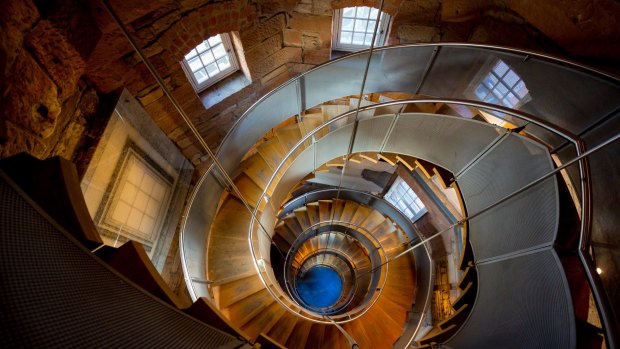
The spiral staircase to the viewing platform in the Mackintosh Tower at the Lighthouse - Scotland's National Centre for Design and Architecture, in the city centre of Glasgow.
Now the Lighthouse, it houses Scotland's National Centre for Design and Architecture, with a viewing platform, accessible via an elaborate spiral staircase, and a section tracing Mackintosh's genius. In truth, he wasn't widely appreciated in Scotland until after his death – in London in 1928 – but Mackintosh had several loyal Glaswegian patrons, including Kate Cranston, who commissioned him to decorate her Willow Tearooms on Sauchiehall Street.
These will reopen next year (2018) after a major revamp as Miss Cranston's New Tea and Lunch Rooms, with Mackintosh's distinctive thin typeface gracing the signs. Post-walking tour, there are plenty of other spots on the Mackintosh trail. Amble through Kelvingrove Park – one of a string of verdant spaces in a city that means Dear Green Place in Gaelic – and you'll come to the wonderful Kelvingrove Art Gallery and Museum. Iconic Mackintosh high-backed chairs, light fittings and gesso panels are among its exhibits.
There are equally flamboyant furnishings in the House for An Art Lover. Hidden in leafy, jogger-friendly Bellahouston Park, it was built in 1990 using designs that Mackintosh had sketched in 1901 for a competition in a German magazine.
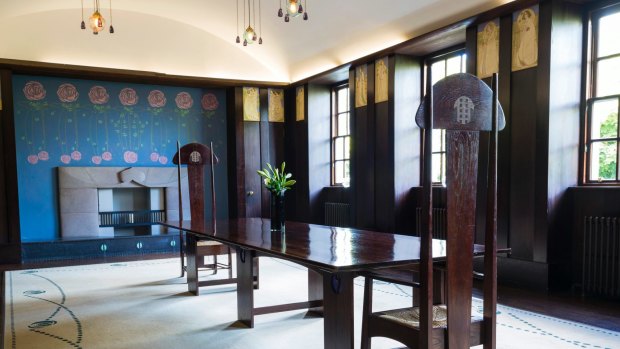
The Dining Room, House for an Art Lover in Bellahouston Park.
The music room, in particular, is a beauty, a gleaming white, piano-blessed space that dazzles even more when sunlight floods in through its windows. Granted, in Glasgow, one of Britain's rainiest cities, that doesn't happen every day, but if the weather's fine – as it is on my visit – the cafe's terrace, edged by manicured lawns and flowerbeds, is a lovely place for coffee or, better still, lunch, with dishes like roasted shallot and smoked brie quiche, fillet of hake with potato and anchovy terrine, and cantaloupe and melon cheesecake as delicious as they are artfully-presented.
TRIP NOTES
MORE
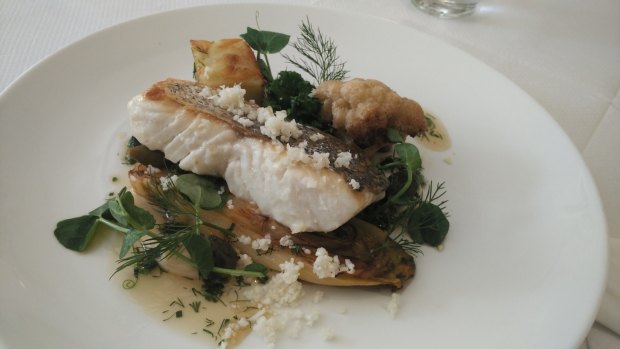
Lunch at House for An Art Lover.Credit: Steve McKenna
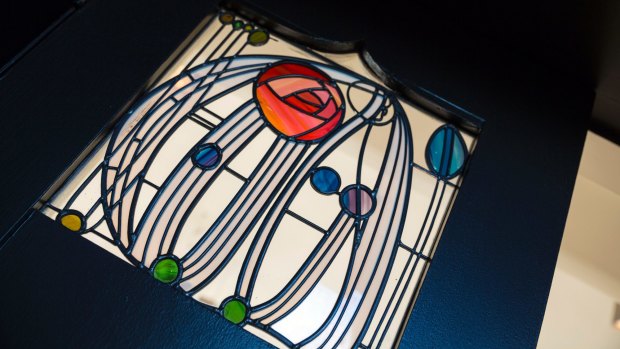
Stained glass rose motif.
FLY
Emirates fly to Glasgow from Sydney and Melbourne via Dubai.
TOUR
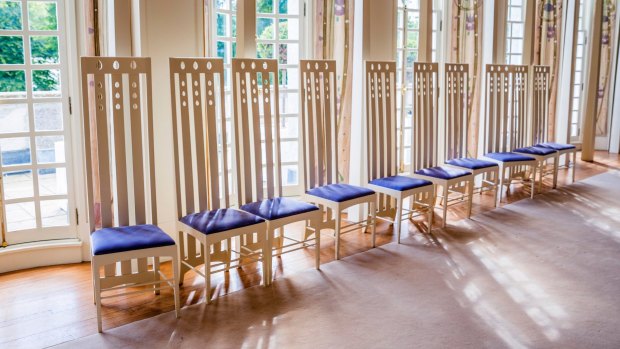
Chairs in the Music Room.
Mackintosh's Glasgow Walking Tours run Friday-Monday between April 1-September 30, and on Saturdays October-March. Starting at 1.30pm, it's priced £19.50 ($33) for adults; gsa.ac.uk
Steve McKenna was a guest of Visit Scotland and Glasgow Life.
Sign up for the Traveller Deals newsletter
Get exclusive travel deals delivered straight to your inbox. Sign up now.